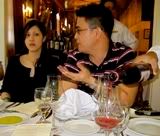
I've been suffering from a upper respiratory tract infection since Monday, which turned into fever and chills Tuesday night. Thus, I had to miss a wine lunch with the Doc and Stockbroker, as well as two wine tastings this week - no sense drinking fine wine or attending evaluative tastings when one's nose and palate are impaired by sickness and medication. Feeling materially better on Thursday (30th April 2009), I attended the lunch/olive oil/wine tasting hosted by Aaron and Jo Palileo at Chef Gene Gonzalez's San Juan culinary landmark,
Café Ysabel.
I was really looking forward to this event since I've never been to an olive oil tasting before. Apparently, Aaron's family business imports and distributes olive oil as well as wine.
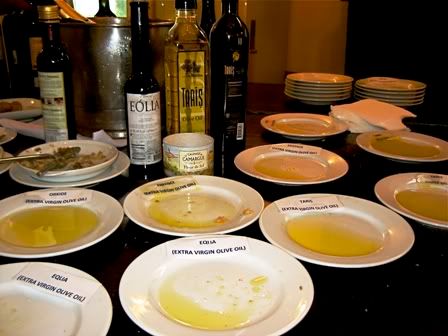
Since I had to pass by the office first and deal with the rainy day Makati traffic, however, I arrived almost an hour late. The guys had finished the olive oil tasting proper, but Gene thoughtfully took the time to guide me through them anyway, with, of course, a welcome glass of well-chilled, clean, roundly fruited and brightly crisp
2004 Freixenet Cava Cuvée D.S., one of the better locally available cavas I've tried.
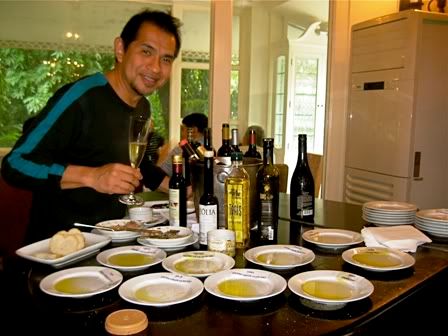
Though, admittedly, I wasn't able to taste all of the olive oils, Gene made sure I was able to taste the
Taris Erkence Extra Virgin Olive Oil - a Turkish first cold press, light on the palate but suavely commanding in presence, with an earthy character to its definitive olive flavor. Slathered on bread with a light sprinkle of
Le Saunier de Camargue Fleur de Sel, you need not much else but a good glass of wine. A bit of simple, flavorful and rustic goodness, that's the way I like it. There were also some very nice, boldly flavored olives on hand that gave the oil a nice push.
We then joined the others already seated at the wine room for lunch proper, 8 in all, including myself. Gino and Gianinna, probably still busy, joined us much later on.
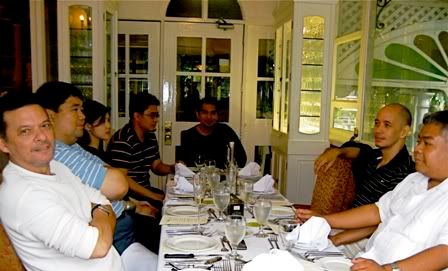
L-R: Johnny R, Arnie, Jo, Aaron, Gene, Marty and J-Lab.
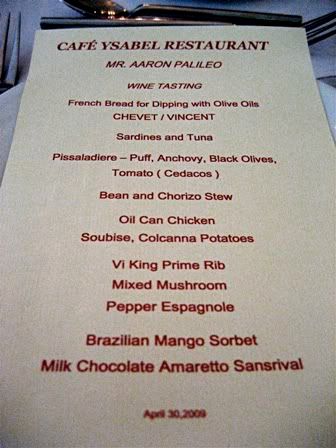
We started off with
Pissaledière, southern France's version of pizza, a specialty of Nice. With this we had...
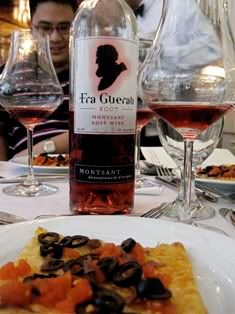 2007 Fra Guerau Montsant Rosado
2007 Fra Guerau Montsant Rosado - Montsant is a Catalonian (northeastern Spain) DO wine region surrounding better known Priorat. Quite dark for a rosé, almost like a claret. Aaron has since informed me that this is made up of syrah, merlot and tempranillo.
This is probably the darkest, fullest, heftiest and most intensely flavored rosé I have ever had, the only other coming close (in heft, but not color) is the 2005 La Rosée de Pavie (the Stockbroker loaded up on a few cases of the latter at only $9 per bottle a few years ago, as I recall). At 13.5%abv, it has the same alcohol level as many traditional Bordeaux reds.
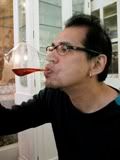
I have no idea what the proportions of the grapes are in this, but I sure did taste the strong influence of syrah. Lots of ripe, spicy, mildly black peppery raspberry and cherry in this. Slight cassis with Provençal-esque nuances underneath, with a pronounced minerality and a faintly medicinal character surfacing mid-mouth. Smooth enough, it is a heavy yet mellow rosé. Nice match for the
pissaledière, particularly the black olives. I would imagine this heavyweight rosé would have no problems pairing with roast rack of lamb.
Next, with a very nice and comforting
Bean & Chorizo Stew (Gene would not agree with the parallels drawn by some to fabada), we had...
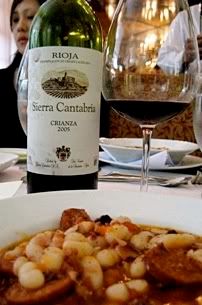 2005 Sierra Cantabria Rioja Crianza
2005 Sierra Cantabria Rioja Crianza - From the outset, this displayed typical Rioja tempranillo flavors: a strawberry and slightly plummy base with topnotes of tartish cherries. The fruit was ripe, but nowhere near the usual super-ripeness of old world 2005s, but nicely fresh. I liked the balance of the acidity just coming over the the fruit.
Firm wine, a good, straightforward, proper Rioja crianza. The wood is well in check and proper, allowing the wine a nice lift that made it a good contrasting match with the soft, earthy goodness of the beans, and, it was also sturdy enough to stand up to the slightly spicy chorizos.
Those looking for typical 2005 over-ripe fruit bombs heavily laced with oak should look elsewhere. Me, I liked this honest and proper Rioja crianza. Good typicity. I would buy this wine.
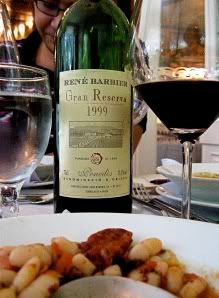 1999 René Barbier Gran Reserva (Penedès)
1999 René Barbier Gran Reserva (Penedès) - Very good vintage for the Pendès DO (also in Catalunya), much better than in Rioja, probably comparable to the vintage of Ribera del Duero, but at the same level as Navarra.
First things first; everything in its place - this is clearly a superior wine compared to the immediately above discussed. However, this is much more mature and a Gran Reserva at that, a different animal altogether - definitely it cannot be anywhere near in price to the latter - and shouldn't fairly be compared head-to-head thereto.
This was a suave, confident, more complex wine with violets on the nose and chocolate, leather and slight kirsch to the mellowed, well-knit, softly mature fruit. Warm and somber. I would buy this wine and could definitely drink this on rainy evenings at home.
With the next course of
Oil Can Chicken with Soubise and Colcanna Potatoes*, we had the next two reds....
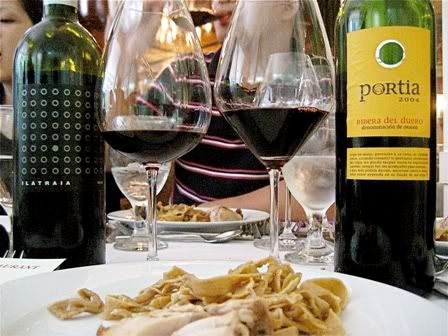 *There must have been a last-minute change in the menu as I don't remember any Colcanna potatoes.2006 Brancaia Ilatraia
*There must have been a last-minute change in the menu as I don't remember any Colcanna potatoes.2006 Brancaia Ilatraia - A very young IGT from Tuscany. For those not familiar, IGT stands for "Indicazione Geografica Tipica" - simply put, it is a relatively modern Italian classification that allows for grapes not native or traditional to an area to be used in making wine. Some so-called "Super Tuscan" (a term coined by Parker) IGTs are Sassicaia and Solaia (both use cabernet sauvignon & cabernet franc), Tignanello ( a blend of sangiovese & cabernet sauvignon) and Masseto (almost pure, if not pure merlot).
I didn't get to read what grapes went into this wine, but it was definitely driven by ripely sweet dried fruit that had an almost raisiny character to it. Reminded me somewhat of
a recent Amarone I had. There were minor notes of dried fig, dates and a whisper of tobacco and leather in this sweetly ripe wine. A bit of heat on the nose, but that is very understandable for a wine so young. Lots of buttressing wood, but I think this will integrate well. Lowish acid, rounded fruit - contrived and manipulated to me.
Personally, this is not a style I favor, but I think this could be a crowd pleaser, especially for those who like Australian reds, since it is neither a stern nor challenging wine - quite the contrary, it is easily approachable and richly flavored, if not intellectual or materially complex. I would buy this wine, however, for guests who like this style.
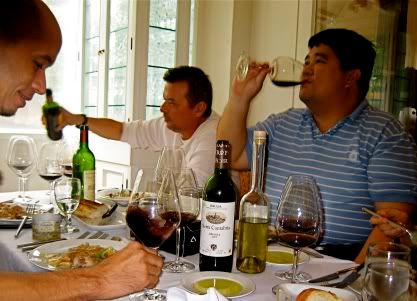 2004 Portia Ribera del Duero
2004 Portia Ribera del Duero - A tad thin on the palate with sourish cherries, a hint of mocha and slight vanilla/coconut cream/oak (likely American oak was used). Simon Cowell's favorite terms "boring" and "forgettable" come to mind. There is nothing wrong or particularly objectionable about this wine, it just doesn't have anything that makes an impression on me at this point. I expected a little more ripeness and character from such a warm vintage. As it was, it didn't even show me any vintage characteristics at this point, and I doubt it ever will. Even if this were sold cheap, I wouldn't buy this wine.
We then moved on to the meat course,
Viking Prime Rib with Mixed Mushrooms and Pepper à l'Espagnole. I failed to take a picture of this prime rib dish, but, take my word for it, it was huge and served in man-sized chunks, nicely bloody just how I like it - and, as I imagine, as would have the ancient Nordic marauders as well. With this meaty madness we had...
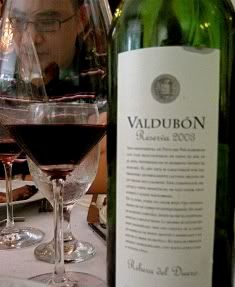 2003 Valdubón Reserva Ribera del Duero
2003 Valdubón Reserva Ribera del Duero - I recall that this wine drew similar reactions from Gene and J-Lab, in that they both thought this to be quite oaky - to the point that Gene said it came off as more Rioja than Ribera del Duero.
I agree that spicy/toasty oak/vanilla was very apparent in this wine's aroma and flavors. Coconut-cream, cinammon and toffee notes indicate to me a lot of exposure to/ageing in new, predominantly American oak barrels, possibly in barriques. Long-ageing in predominantly American oak is a traditional Rioja style - so that's likely why Gene said it came off as a Rioja.
It's dark fruit, while ripe, roasted and plummy, seemed to lack freshness and push, thereby allowing even more emphasis on the wood - which possibly contributed even more to the Rioja-esque feel.
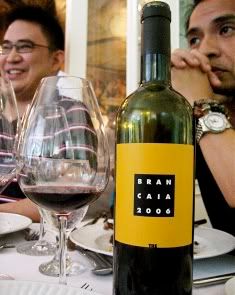 2006 Brancaia Tre
2006 Brancaia Tre - I failed to ask what went into this wine, but it tasted of sweetish-tart cherries, raspberries, a bit of leather and spicy wood. Nicely firm structure, good focus..
It was pleasing enough up front, revealing some violet nuances mid-mouth and towards the back, but failed to see things through to the end - the finish a bit abrupt and abandoning. It feels like it is holding back.
This is still a very young wine, it likely may have gone to sleep already. As it is now, it comes off superficially as a pleasant, somewhat charming, but simple wine. It may have something interesting to say in the future, but I can't be sure. It might, but only time will surely tell.
Its firmness and focus made it pair acceptably with the prime rib, which, since not aggressively flavored, did not emphasize the wine's relatively short finish.
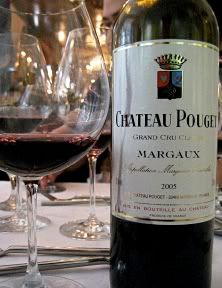 2005 Château Pouget
2005 Château Pouget - A grand cru classé, a little known 4th growth in the 1855 Classification - I do not recall ever having tried any wine from this château, so was thankful for the opportunity.
This wine was initially quite reluctant, giving off a rusty, somewhat stemmy, bell pepper-like aroma which Jo also noted. In the mouth, it was very tight. Given that in my last tasting of a wide range of '05 Bdx (late May 2008, UGC tasting, Vinexpo HK) I felt that most Médocs had gone to sleep, I nursed my glass for approximately 45 minutes or so, just sniffing once in a while, before re-tasting.
After material aeration, it did open up (and I told Aaron that it did) giving off delicately cedar-and-violet-laced notes of plum, cassis, black cherry, a whisper of licorice and fine, dark minerality.
Nice finish/length. Quite proper and austere, not showing the ripe/roastedness of the vintage (which is not necessarily a bad thing). I'd guess that this will turn out to be more like an old school Margaux (which is a good thing, for me, anyway) and would certainly like to revisit this wine in around 4-5 years to see how it comes along.
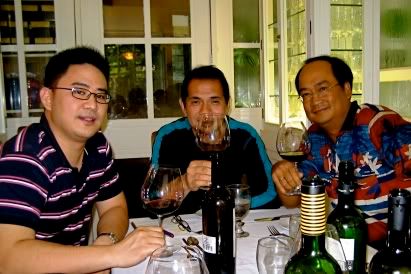
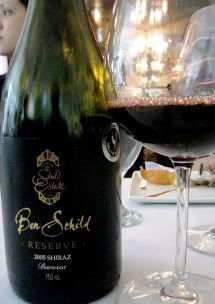 2005 Schild Estate Ben Schild Reserve Shiraz
2005 Schild Estate Ben Schild Reserve Shiraz - The only new world wine of the lunch. I guess this was opened last as, after already having gone through 9 wines (including the cava), anything less large would, possibly, wind up tasting like water - and large this southern Aussie wine was in fruit, no question about that.
Rich, rounded, big, yet very pliant, entertainingly chewy mouthfeel. Undeniably very ripe, the dark fruit was sweet with a baked character to it. There were minor notes of black pepper, bit of chocolate and, to a lesser extent, violets.
Dense and viscous in its ripe-fruited sweetness, taking into account the chocolate notes, I guess this was meant to pair with our dessert of
Milk Chocolate Amaretto Sans Rival with a Brazilian Mango Sorbet. Pity though that this (assumed) pairing didn't come to my mind as I devoured my dessert so fast (sans rival happens to be one of my favorite desserts - has been since 5th grade) I forgot to take a picture of it, much less sip the wine.
By itself, I found the wine too cumbersomely rich and a bit cloying. Would I have enjoyed it with the chocolate sans rival? Perhaps, an indulgent "running with the ball" type of pairing. I am no big fan of pairing reds with chocolate, though. I've tried it several times, and the only truly memorable match I've had thus far has been a 1979 Domaine du Mas Blanc Banyuls Cuvée St. Martin (from Bernie Sim) which I served with Chocolate Marquis on a bed of Macerated

Cherries during the 23rd February 2007 dinner of the Manila Gentlemen's Club.
A double espresso wound down things for me - little did I suspect that this would turn into yet another 6+ hour wine lunch. That seems to be happening all too often as of late. Gene snuck in a few winks during the dessert course until roused by my question as to the origins of the sans rival. Of course, of those present, only he could answer that definitively, and with detail to spare.
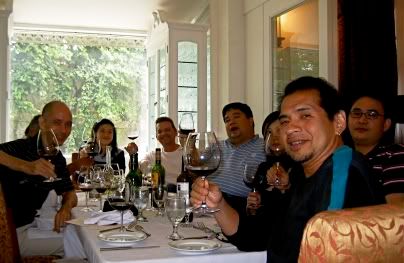
And so ended an extended olive oil and wine tasting lunch. Great way to end the week and kick off a 3-day weekend - especially since the next day was to be my birthday. Many thanks Aaron and Gene for inviting us, and hosting and entertaining us in such fine fashion.
 I spilled a bit of wine on my menu, hence the smudge on the lower left - you really can't take me anywhere.
I spilled a bit of wine on my menu, hence the smudge on the lower left - you really can't take me anywhere.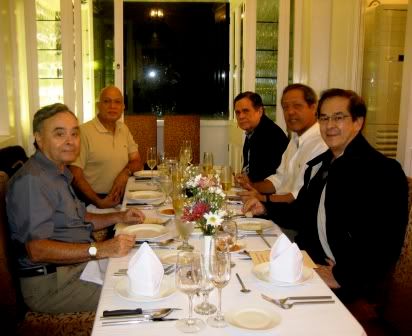
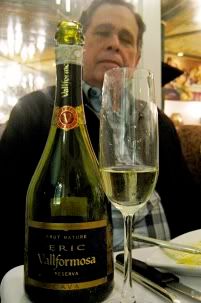 Masia Eric de Vallformosa Reserva Brut Nature - a sparkling wine from the Cava D.O., the grapes of which (55% parellada, 45% chardonnay) come from vineyards of Mas Baltà in the Alt Penedès comarca (Catalunya). What immediately struck me in this cava was its very fine, yet persistent mousse. I rarely see such a delicate stream of small bubbles in the cavas I've had. Even the mouthfeel was vaguely champagne-esque, almost still from the attack but expanding and frothing upon reaching mid-mouth and beyond.
Masia Eric de Vallformosa Reserva Brut Nature - a sparkling wine from the Cava D.O., the grapes of which (55% parellada, 45% chardonnay) come from vineyards of Mas Baltà in the Alt Penedès comarca (Catalunya). What immediately struck me in this cava was its very fine, yet persistent mousse. I rarely see such a delicate stream of small bubbles in the cavas I've had. Even the mouthfeel was vaguely champagne-esque, almost still from the attack but expanding and frothing upon reaching mid-mouth and beyond.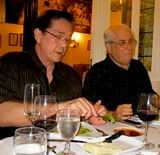 Everyone was enjoying the Lavosh Bread and Dip so much, including myself. Some asked our waiter what went into the vaguely fruity, sweetly-spicy dip aside from the obvious olive oil and balsamico, but he replied that it was a secret. Fair enough, we just continued dipping the excellent lavosh in it. I had to eventually remind the others that we had a lot of food coming - after all, man does not live on bread alone.
Everyone was enjoying the Lavosh Bread and Dip so much, including myself. Some asked our waiter what went into the vaguely fruity, sweetly-spicy dip aside from the obvious olive oil and balsamico, but he replied that it was a secret. Fair enough, we just continued dipping the excellent lavosh in it. I had to eventually remind the others that we had a lot of food coming - after all, man does not live on bread alone. ...the lightly honeyed dressing of which Bob immediately noted to have a touch of curry spice in it. I actually didn't notice that until I tasted it. A breath of curry spice indeed, which added an interesting twist and a touch of complexity to the simple greens and smoked salmon. Mon and Oscar apparently enjoy this a lot since they requested for extra servings of the greens. Oscar experimented with some of his extra greens by using the lavosh's dip as a dressing, and pronounced it delicious.
...the lightly honeyed dressing of which Bob immediately noted to have a touch of curry spice in it. I actually didn't notice that until I tasted it. A breath of curry spice indeed, which added an interesting twist and a touch of complexity to the simple greens and smoked salmon. Mon and Oscar apparently enjoy this a lot since they requested for extra servings of the greens. Oscar experimented with some of his extra greens by using the lavosh's dip as a dressing, and pronounced it delicious.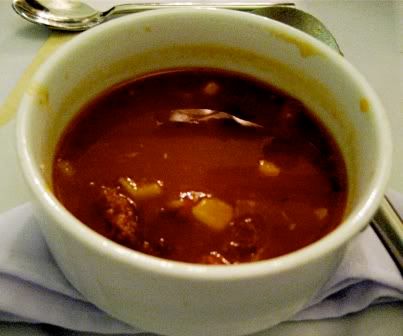 Full of earthy and spicy flavors, this hearty soup was perfect for such a rainy night. I happen to love both lentejas and chorizo, and, so, particularly enjoyed this.
Full of earthy and spicy flavors, this hearty soup was perfect for such a rainy night. I happen to love both lentejas and chorizo, and, so, particularly enjoyed this.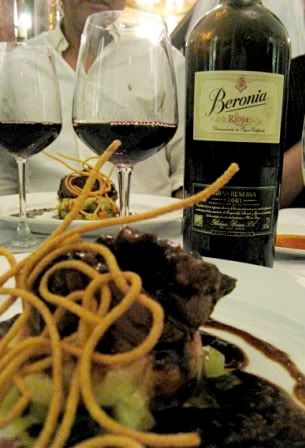 2001 Bodegas Beronia Rioja Gran Reserva - Bodegas Beronia is located in Ollauri, Rioja Alta, named after the Berones people who occupied the general area since the 3rd century B.C. Employing "modern" techniques (i.e., oak ageing is shorter than the traditional method and French oak is used together with American oak), their wines are more suave, lighter on their feet and less ponderously woody than "old school" Riojas, as accurately noted by Mackie. The grapes used in this were tempranillo (87%), mazuelo (8%) graciano and (5%). As Spanish wine aficinados already know, 2001 was an exceptionally good Rioja vintage.
2001 Bodegas Beronia Rioja Gran Reserva - Bodegas Beronia is located in Ollauri, Rioja Alta, named after the Berones people who occupied the general area since the 3rd century B.C. Employing "modern" techniques (i.e., oak ageing is shorter than the traditional method and French oak is used together with American oak), their wines are more suave, lighter on their feet and less ponderously woody than "old school" Riojas, as accurately noted by Mackie. The grapes used in this were tempranillo (87%), mazuelo (8%) graciano and (5%). As Spanish wine aficinados already know, 2001 was an exceptionally good Rioja vintage.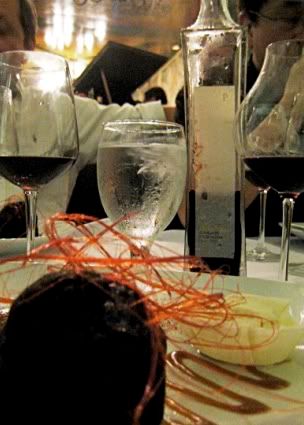 2007 Celler Piñol Vi Dolç (Tinto) - Another Catalàn wine, this time from the comarca Terra Alta, made up mainly of late harvested, over-matured grenache grapes from old vines. I've written about Piñol's 2005 Vi Dolç before - first having tasted this at Gene's 50th birthday dinner, paired with decadent chocolate treats. This 2007 version was very similar.
2007 Celler Piñol Vi Dolç (Tinto) - Another Catalàn wine, this time from the comarca Terra Alta, made up mainly of late harvested, over-matured grenache grapes from old vines. I've written about Piñol's 2005 Vi Dolç before - first having tasted this at Gene's 50th birthday dinner, paired with decadent chocolate treats. This 2007 version was very similar.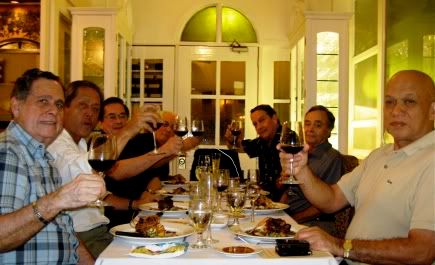 L-R: Mari Cacho, Mackie Cui, Oscar Rodriguez, Jimmy Alba, Mon Infante, Bob Paradies and Sal Lacson
L-R: Mari Cacho, Mackie Cui, Oscar Rodriguez, Jimmy Alba, Mon Infante, Bob Paradies and Sal Lacson




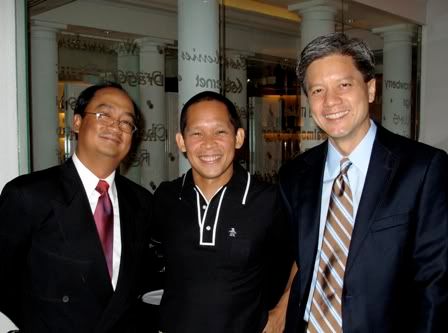 As usual, the Stockbroker was the most liesurely dressed among us three...
As usual, the Stockbroker was the most liesurely dressed among us three...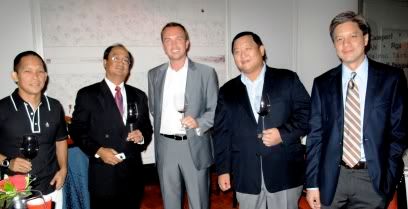
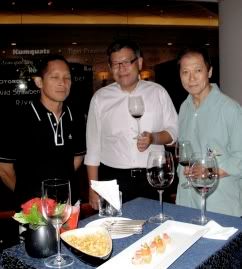
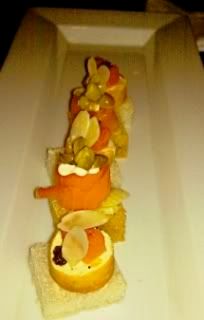 ...and glasses of La Chapelle's "little brother"...
...and glasses of La Chapelle's "little brother"...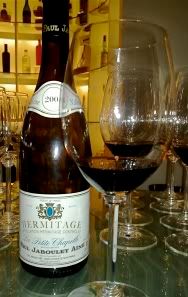
 Dinner was then served.
Dinner was then served.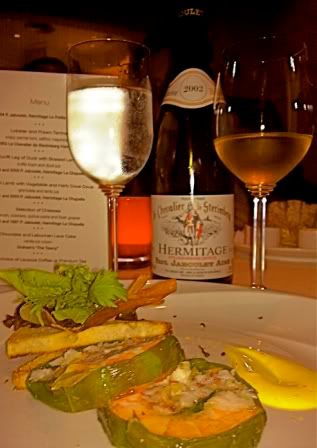 2002 Jaboulet Hermitage Chevalier de Sterimberg - Jaboulet's Hermitage blanc, made up of marsanne with a significantly lower proportion of roussanne. This bottling is was named after Gaspard de Stérimberg, a knight who, in 1235, built the earlier mentioned chapel dedicated to St. Cristophe. 2002 was, to put it lightly, an extremely challenging vintage for the northern Rhône blancs; and a 2002 Guigal Hermitage Blanc I opened a few months ago, let's just say, was no strong argument for whatever little merit this vintage may be imagined to possess for the blancs.
2002 Jaboulet Hermitage Chevalier de Sterimberg - Jaboulet's Hermitage blanc, made up of marsanne with a significantly lower proportion of roussanne. This bottling is was named after Gaspard de Stérimberg, a knight who, in 1235, built the earlier mentioned chapel dedicated to St. Cristophe. 2002 was, to put it lightly, an extremely challenging vintage for the northern Rhône blancs; and a 2002 Guigal Hermitage Blanc I opened a few months ago, let's just say, was no strong argument for whatever little merit this vintage may be imagined to possess for the blancs.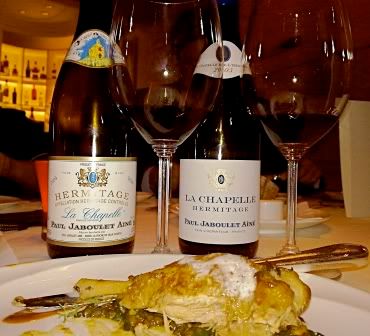 2005 and 2004 Jaboulet Hermitage La Chapelle - The difference between the two vintages was apparent from the outset as the 2005 clearly had warmer, riper, oakier and comparatively more forward aromas than the 2004; whereas the latter's were reticent and more herbal and mineral in character than the openly fruit-froward and oaky 2005. Said difference was mirrored in the mouth, where the 2005 showed a heftier and ripely sweetish fruit middle with more cinammon/toasty/creamy oak than the restrained, tighter and less ripe 2004.
2005 and 2004 Jaboulet Hermitage La Chapelle - The difference between the two vintages was apparent from the outset as the 2005 clearly had warmer, riper, oakier and comparatively more forward aromas than the 2004; whereas the latter's were reticent and more herbal and mineral in character than the openly fruit-froward and oaky 2005. Said difference was mirrored in the mouth, where the 2005 showed a heftier and ripely sweetish fruit middle with more cinammon/toasty/creamy oak than the restrained, tighter and less ripe 2004.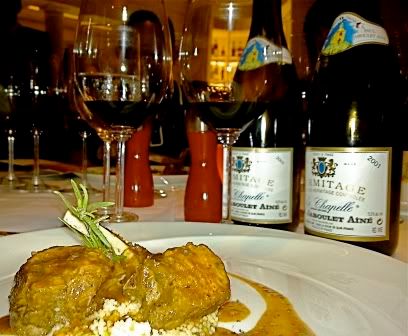 2003 and 2001 Jaboulet Hermitage La Chapelle - Between these two wines as well was a readily apparent contrast in vintage characteristics. The 2003, more like the 2005, was riper, more forward and lusher in fruit than the 2001 but with a more savory, meatier, less creamily oaked character than the 2005. The 2001 had more acidic lift and came off a bit linear, more somber and backward, which is pretty much the same as when I tested a bottle a few years ago with the Doc and Stockbroker. The 2003, to my mind, is a wine to be enjoyed sooner and I'd wait a few more years to see if the more vin de garde styled 2001 will open up more.
2003 and 2001 Jaboulet Hermitage La Chapelle - Between these two wines as well was a readily apparent contrast in vintage characteristics. The 2003, more like the 2005, was riper, more forward and lusher in fruit than the 2001 but with a more savory, meatier, less creamily oaked character than the 2005. The 2001 had more acidic lift and came off a bit linear, more somber and backward, which is pretty much the same as when I tested a bottle a few years ago with the Doc and Stockbroker. The 2003, to my mind, is a wine to be enjoyed sooner and I'd wait a few more years to see if the more vin de garde styled 2001 will open up more.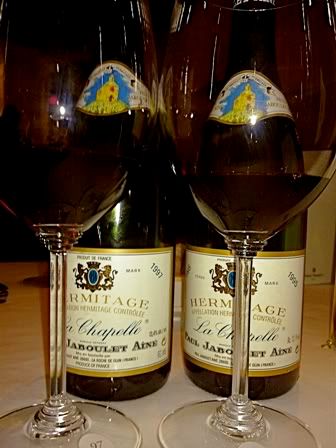 1997 and 1995 Jaboulet Hermitage La Chapelle - Things got a lot more interesting with these vintages; as I mentioned earlier, La Chapelles need many years to strut their stuff - and these two were in fine stride. Showing off their complex characters, both proudly displayed their mature, smoky dark cherry, raspberry, cassis, truffle, bacon fat, roast meat, leather, tobacco, garrigue and cedar notes gently flecked with black pepper. The 1997 seemed comparatively sweeter and softer in fruit and more approachable than the earthier, more savory, solidly structured 1995. Both were excellent, clearly showcasing, in two distinct manners, the true beauty of mature La Chapelles.
1997 and 1995 Jaboulet Hermitage La Chapelle - Things got a lot more interesting with these vintages; as I mentioned earlier, La Chapelles need many years to strut their stuff - and these two were in fine stride. Showing off their complex characters, both proudly displayed their mature, smoky dark cherry, raspberry, cassis, truffle, bacon fat, roast meat, leather, tobacco, garrigue and cedar notes gently flecked with black pepper. The 1997 seemed comparatively sweeter and softer in fruit and more approachable than the earthier, more savory, solidly structured 1995. Both were excellent, clearly showcasing, in two distinct manners, the true beauty of mature La Chapelles.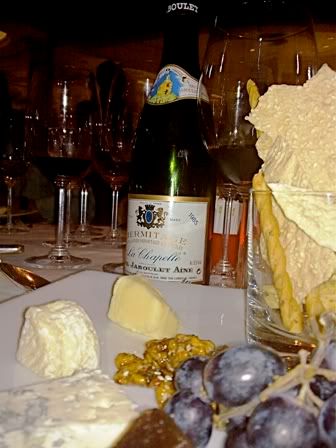 1985 Jaboulet Hermitage La Chapelle - This wine had the most alluring bouquet of subtle game, sweet bacon fat and smoky cedar delicately lacing the seamlessly silky-smooth, pure, soft raspberry, cherry and cassis elixir. Discreet, well-worn leather, walnut, truffle and tobacco notes finely woven into the underlying cassis added even more complexity and depth. Great balance, if not as firmly structured as the 1995 at this point. Contemplative, intellectual, yet suave and confident, excellent wine.
1985 Jaboulet Hermitage La Chapelle - This wine had the most alluring bouquet of subtle game, sweet bacon fat and smoky cedar delicately lacing the seamlessly silky-smooth, pure, soft raspberry, cherry and cassis elixir. Discreet, well-worn leather, walnut, truffle and tobacco notes finely woven into the underlying cassis added even more complexity and depth. Great balance, if not as firmly structured as the 1995 at this point. Contemplative, intellectual, yet suave and confident, excellent wine.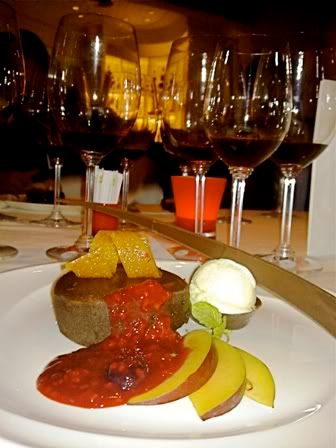 ...with glasses of Graham's "The Tawny" Port.
...with glasses of Graham's "The Tawny" Port.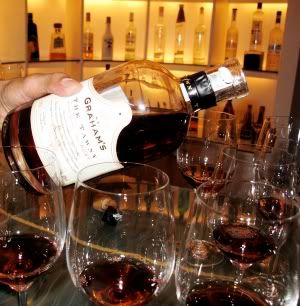 A Lavazza double espresso and a few more stories with Bernie and Oscar ended yet another memorable wine dinner. I would have loved to linger over more port and a cigar, but it was a working day the next day after all.
A Lavazza double espresso and a few more stories with Bernie and Oscar ended yet another memorable wine dinner. I would have loved to linger over more port and a cigar, but it was a working day the next day after all. Special mention must be made to Red's excellent sommelier, Ace. As passionately emphasized by Cristophe, proper serving temperature can make or break a wine's showing at any tasting. Ace took every effort to insure that all the evening's wines were served at their best. Good show, Ace.
Special mention must be made to Red's excellent sommelier, Ace. As passionately emphasized by Cristophe, proper serving temperature can make or break a wine's showing at any tasting. Ace took every effort to insure that all the evening's wines were served at their best. Good show, Ace.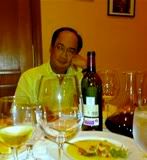
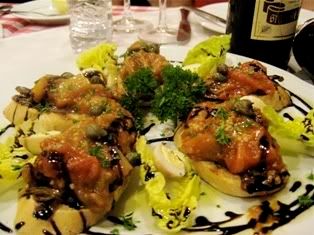


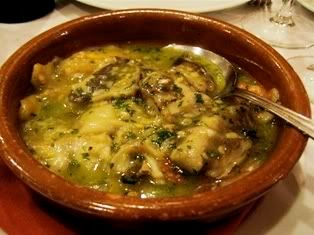
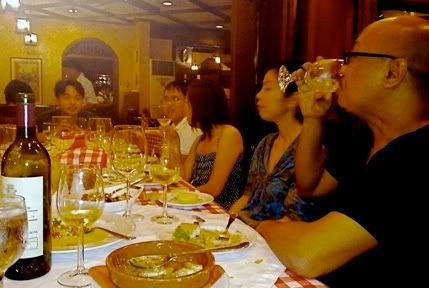 With these excellent starters, I paired...
With these excellent starters, I paired...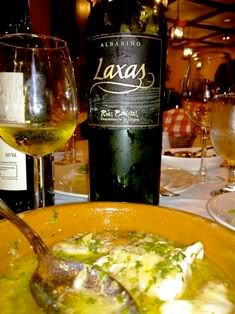
 The next gustatory salvo was made up of Paella de Verduras (made with Basmati rice) and Besugo al Horno...
The next gustatory salvo was made up of Paella de Verduras (made with Basmati rice) and Besugo al Horno...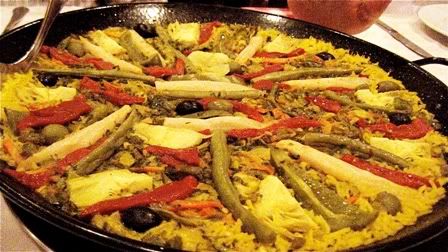
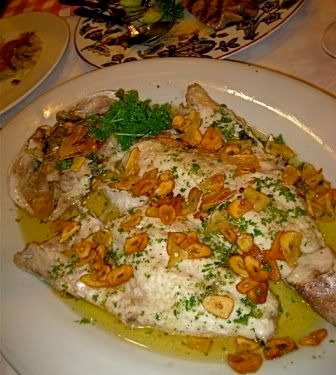 With which I served...
With which I served...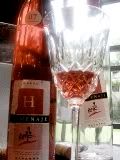
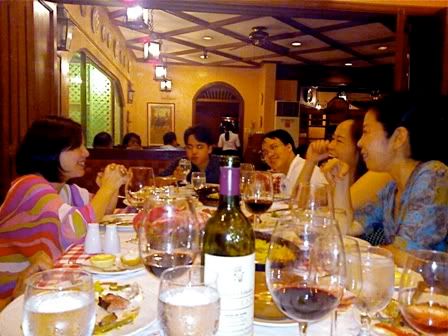 Thereafter came the Chuleton...
Thereafter came the Chuleton...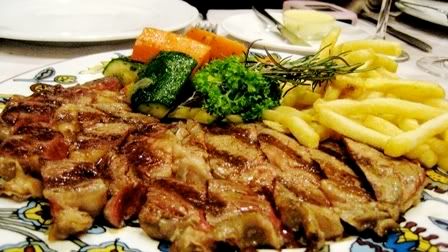 ...which I paired with...
...which I paired with...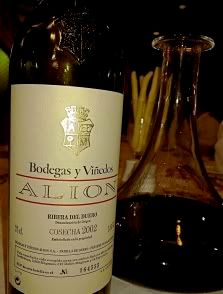
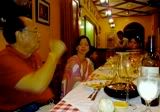
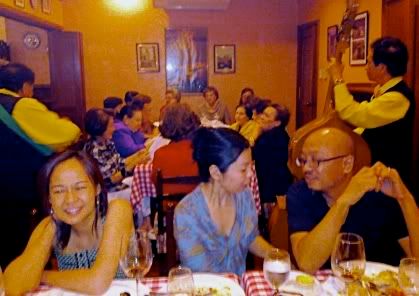 The other long table next to us was filled with abuelas, likewise celebrating a birthday I believe. They kept the resident "Trio los Panchos" busy with requests for Spanish songs as they sang along. We didn't mind at all, it added to the celebratory air; we actually sang along with a few songs. They even played a couple of old songs "Pregúntale á las Estrellas" and "El Reloj y La Vela" which my late mom used to sing to my dad when they were young.
The other long table next to us was filled with abuelas, likewise celebrating a birthday I believe. They kept the resident "Trio los Panchos" busy with requests for Spanish songs as they sang along. We didn't mind at all, it added to the celebratory air; we actually sang along with a few songs. They even played a couple of old songs "Pregúntale á las Estrellas" and "El Reloj y La Vela" which my late mom used to sing to my dad when they were young.
 Since I had to pass by the office first and deal with the rainy day Makati traffic, however, I arrived almost an hour late. The guys had finished the olive oil tasting proper, but Gene thoughtfully took the time to guide me through them anyway, with, of course, a welcome glass of well-chilled, clean, roundly fruited and brightly crisp 2004 Freixenet Cava Cuvée D.S., one of the better locally available cavas I've tried.
Since I had to pass by the office first and deal with the rainy day Makati traffic, however, I arrived almost an hour late. The guys had finished the olive oil tasting proper, but Gene thoughtfully took the time to guide me through them anyway, with, of course, a welcome glass of well-chilled, clean, roundly fruited and brightly crisp 2004 Freixenet Cava Cuvée D.S., one of the better locally available cavas I've tried. Though, admittedly, I wasn't able to taste all of the olive oils, Gene made sure I was able to taste the Taris Erkence Extra Virgin Olive Oil - a Turkish first cold press, light on the palate but suavely commanding in presence, with an earthy character to its definitive olive flavor. Slathered on bread with a light sprinkle of Le Saunier de Camargue Fleur de Sel, you need not much else but a good glass of wine. A bit of simple, flavorful and rustic goodness, that's the way I like it. There were also some very nice, boldly flavored olives on hand that gave the oil a nice push.
Though, admittedly, I wasn't able to taste all of the olive oils, Gene made sure I was able to taste the Taris Erkence Extra Virgin Olive Oil - a Turkish first cold press, light on the palate but suavely commanding in presence, with an earthy character to its definitive olive flavor. Slathered on bread with a light sprinkle of Le Saunier de Camargue Fleur de Sel, you need not much else but a good glass of wine. A bit of simple, flavorful and rustic goodness, that's the way I like it. There were also some very nice, boldly flavored olives on hand that gave the oil a nice push.
 We started off with Pissaledière, southern France's version of pizza, a specialty of Nice. With this we had...
We started off with Pissaledière, southern France's version of pizza, a specialty of Nice. With this we had...
 I have no idea what the proportions of the grapes are in this, but I sure did taste the strong influence of syrah. Lots of ripe, spicy, mildly black peppery raspberry and cherry in this. Slight cassis with Provençal-esque nuances underneath, with a pronounced minerality and a faintly medicinal character surfacing mid-mouth. Smooth enough, it is a heavy yet mellow rosé. Nice match for the pissaledière, particularly the black olives. I would imagine this heavyweight rosé would have no problems pairing with roast rack of lamb.
I have no idea what the proportions of the grapes are in this, but I sure did taste the strong influence of syrah. Lots of ripe, spicy, mildly black peppery raspberry and cherry in this. Slight cassis with Provençal-esque nuances underneath, with a pronounced minerality and a faintly medicinal character surfacing mid-mouth. Smooth enough, it is a heavy yet mellow rosé. Nice match for the pissaledière, particularly the black olives. I would imagine this heavyweight rosé would have no problems pairing with roast rack of lamb.


 2004 Portia Ribera del Duero - A tad thin on the palate with sourish cherries, a hint of mocha and slight vanilla/coconut cream/oak (likely American oak was used). Simon Cowell's favorite terms "boring" and "forgettable" come to mind. There is nothing wrong or particularly objectionable about this wine, it just doesn't have anything that makes an impression on me at this point. I expected a little more ripeness and character from such a warm vintage. As it was, it didn't even show me any vintage characteristics at this point, and I doubt it ever will. Even if this were sold cheap, I wouldn't buy this wine.
2004 Portia Ribera del Duero - A tad thin on the palate with sourish cherries, a hint of mocha and slight vanilla/coconut cream/oak (likely American oak was used). Simon Cowell's favorite terms "boring" and "forgettable" come to mind. There is nothing wrong or particularly objectionable about this wine, it just doesn't have anything that makes an impression on me at this point. I expected a little more ripeness and character from such a warm vintage. As it was, it didn't even show me any vintage characteristics at this point, and I doubt it ever will. Even if this were sold cheap, I wouldn't buy this wine.





 And so ended an extended olive oil and wine tasting lunch. Great way to end the week and kick off a 3-day weekend - especially since the next day was to be my birthday. Many thanks Aaron and Gene for inviting us, and hosting and entertaining us in such fine fashion.
And so ended an extended olive oil and wine tasting lunch. Great way to end the week and kick off a 3-day weekend - especially since the next day was to be my birthday. Many thanks Aaron and Gene for inviting us, and hosting and entertaining us in such fine fashion.